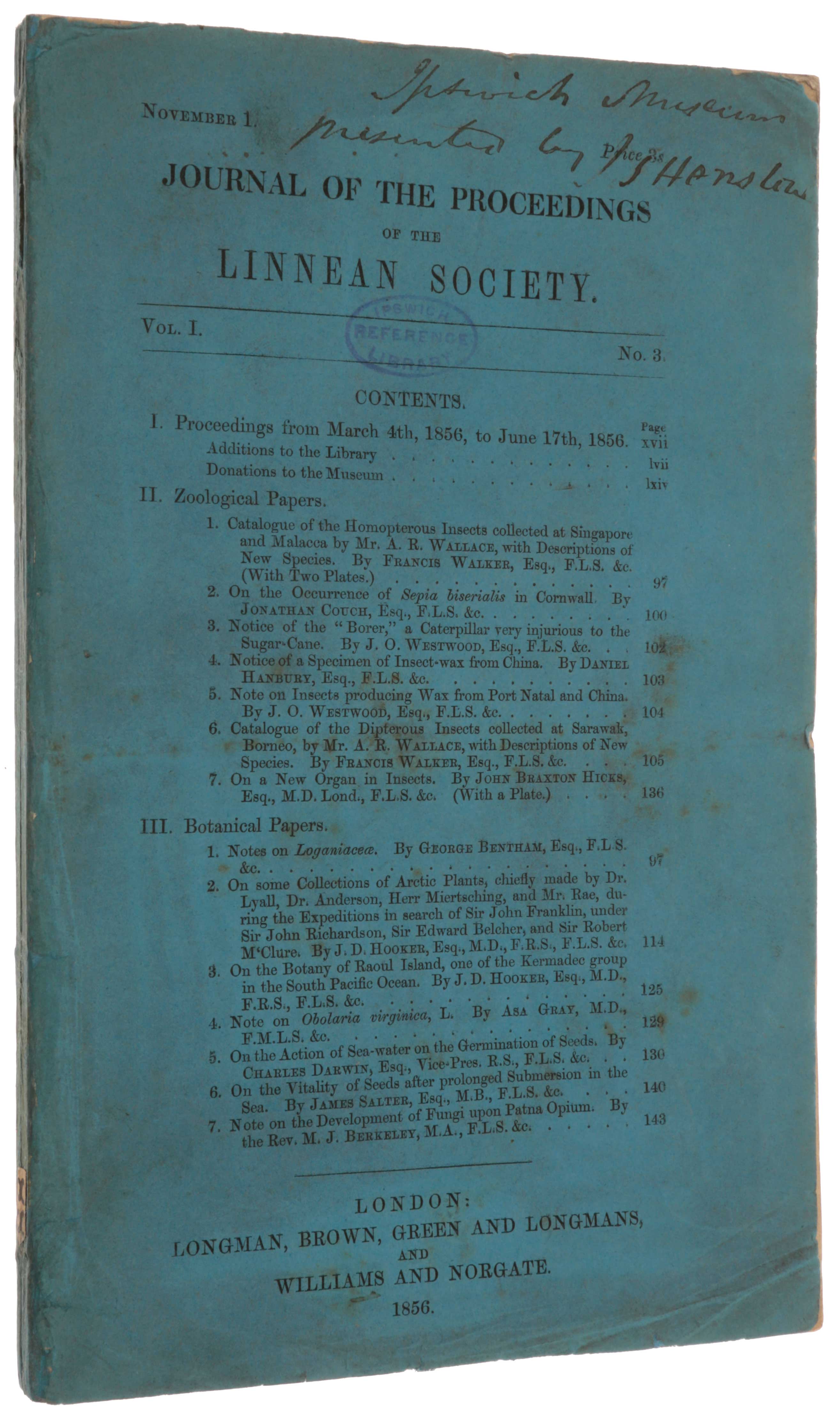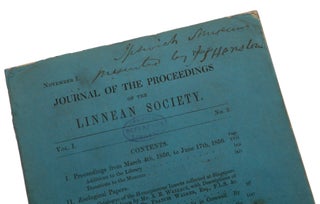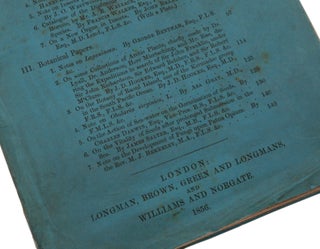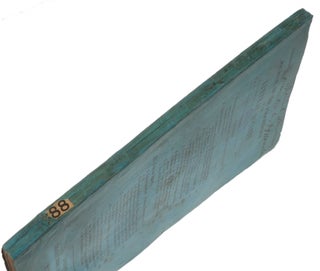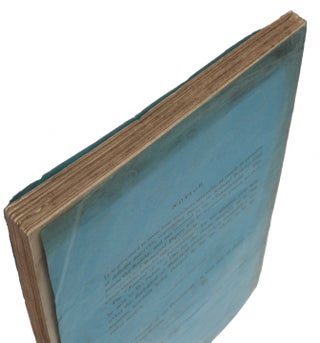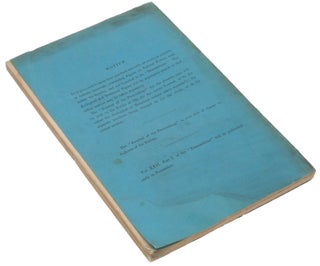On the action of sea-water on the germination of seeds, pp. 130-140 in: Journal of Proceedings of the Linnean Society of London (Botany), vol. 1, no. 3.
London: Longman, Brown, Green & Longmans and Williams & Norgate, 1856. First edition, journal issue in original printed wrappers, and a remarkable association copy, of this important contribution of Darwin to biogeography. This copy was presented by John Stevens Henslow, perhaps the single most influential person in leading Darwin onto his remarkable path. “During his five-year journey around the world on HMS Beagle, Charles Darwin encountered many different landscapes and an enormous variety of flora and fauna. Some of his most vivid experiences were on the islands of the coast of South America, including the now-famous Galapagos archipelago. Darwin was fascinated by the geographic relationship between the South American coast and its nearby islands; he puzzled over why plants and animals on nearby islands were similar to those on the mainland. Darwin was not satisfied by the traditional explanation provided by many naturalists of his day (including the famous Harvard naturalist Louis Agassiz), that each organism was specially created for its geographic location. After his return from the Beagle, he started to challenge the tenets of special creation theory. Eventually, Darwin suggested that species were transported from the mainland to the islands, where they continued to evolve. For his theory to work, Darwin had to prove that it was possible for mainland species to be transported across oceans and to survive on nearby islands. In the 1850s he embarked on a series of experiments to demonstrate that a variety of cross-oceanic dispersal methods were possible. He conducted several experiments to test whether the seeds of common garden plants could be soaked in salt water, survive, and germinate. Many of Darwin’s seeds survived this salt-water test, which suggested to Darwin that his theory of seed dispersal and subsequent evolution was plausible … Although these experiments were simple, the results gave Darwin substantial evidence for the role of evolution in the history and distribution of life on earth” (darwinproject.ac.uk/learning/universities/getting-know-darwins-science/biogeography). Also included in this issue are papers by two of Darwin’s most important supporters, the first of which also bears on phytogeography: Joseph Dalton Hooker’s ‘On the botany of Raoul Island, one of the Kermadec group on the South Pacific Ocean’, and Asa Gray’s ‘Note on Obolaria virginica’; there are also two papers on entomology by Alfred Russel Wallace. ABPC/RBH record a single copy (Darwin’s Century, Sotheby’s, 11 December 1992, lot 106). Provenance: John Stevens Henslow (1796-1861), inscribed (probably in his hand) on front wrapper ‘Ipswich Museum / presented by J S Henslow’; Ipswich Museum Reference Library (ink stamp on recto and verso of front wrapper). While a student at Cambridge, Darwin attended the lectures of Henslow, then the Professor of Botany. Darwin became great friends with him, and was known as ‘the man who walks with Henslow’ by the other professors. On Friday evenings Henslow held open house, and Darwin was a regular attendee of these scientific soirees. In his memoires of Henslow, Darwin writes at length on how much he enjoyed and learnt from his time with Henslow, and extensively praises his character. It was also Henslow who suggested to Captain FitzRoy that Darwin should be taken on the voyage of H.M.S. Beagle, and while on this pivotal journey Darwin continued to be aided by Henslow, who received and looked after the specimens Darwin sent back as well continuing to offer advice. By the time Darwin returned home in 1836, his scientific credentials and future scientific career were assured—largely thanks to Henslow. In his autobiography, written towards the end of his life, Darwin described his friendship with Henslow as the most important circumstance in his whole career. “Wind, water, and wing. It is well-accepted today that these are natural means by which the seeds of plants make their way to remote islands. However, in Charles Darwin’s day, things were not so settled. Decades before we understood things like plate tectonics and continental drift, there was ongoing debate about how the flora and fauna residing on islands got there. Were there multiple creation events or were there a series of land bridges and continental extensions now sunken in the sea? Unconvinced of one and skeptical of the other, Darwin embarked on a series of experiments to determine the possibility of an alternate hypothesis: long-distance dispersal. “Darwin wasn’t completely opposed to the idea that some species may have reached remote islands by land bridges of some sort; however, as James T. Costa writes in Darwin’s Backyard, his ‘imagination [ran] wild with scenarios for long-distance transport by floods and currents, whirlwinds and hurricanes, dispersal by birds, rafting quadrupeds carrying seeds in their stomachs or adhering to their fur, floating trees with seeds wedged in root masses, insects with seeds or eggs stuck to their legs, icebergs, and more.’ He was convinced, ‘improbable as it was that, aided by wing or wave, propagules from a mainland could make it to distant islands.’ After all, the vastness of geological time allows for chance events despite how improbable they may be. Even more, such events are ‘testable.’ “So test them, he did. Among a series of experiments regarding long-distance dispersal were Darwin’s extensive seed salting trials. He began by using common vegetable seeds: broccoli, cabbage, oats, radish, lettuce, flax, and many others. He placed seeds in small bottles containing 2-3 ounces of salt water. Some bottles were placed outside in the shade where the air temperature varied throughout the day; other bottles were kept in his cellar where the temperature was more stable. He also placed seeds in a tank of salt water made with melted snow. The water in some of the jars, particularly those with brassica and onion seeds, turned foul, as Darwin writes, ‘smelt offensive to a quite surprising degree;’ however, ‘neither the putridity of the water nor the changing temperature had any marked effect on their vitality.’ “In fact, while a few did quite poorly, the majority of the seeds that Darwin tested germinated just fine after soaking in salt water. At least for a short period anyway. Germination rates tended to decrease dramatically the longer seeds were soaked. For example, ‘fresh seed of the wild cabbage from Tenby germinated excellently after 50 days, very well after 110 days, and two seeds out of some hundreds germinated after 133 days immersion.’ Darwin found that capsicum (i.e., peppers) ‘endured the trial best, for 30 out of 56 seeds germinated well after 137 days immersion.’ “Darwin’s seed salting experiments seemed to be going well until his friend and colleague, Joseph Hooker, pointed out that seeds often sink when placed in water. Darwin wondered if he had been ‘taking all this trouble in salting the ungrateful rascals for nothing.’ Despite the setback, he began another series of tests to determine which seeds sink, which float, and how long they float before they ultimately sink. The results weren’t as bad as expected. A number of species floated for several days, including the seeds of asparagus which were found to float for about 23 days if the seeds were fresh and up to 86 days if they were dried. By his calculations then, ocean currents could carry asparagus seeds over 2800 miles … “Despite a few botched experiments, Darwin turned out to be correct – long-distance dispersal explains much of the geographical distribution of species. Those who favored ideas of sunken land-bridges and continental extensions weren’t altogether wrong either. Costa writes: ‘Ironically, there is a kernel of truth behind the old idea of continental extensionism: rearranged and sometime contiguous continents … explain the distribution of some groups. But chance long-distance dispersal has never gone away. Improbable and rare as such events are, they are far from mysterious, and certainly not miraculous’” (awkwardbotany.com/2018/05/02/the-seed-salting-experiments-of-charles-darwin/). Hooker’s paper also deals with plant geography. It considers the flora of Raoul, or Sunday Island, “as sampled in a collection made by J. McGillivray … The following extract gives the gist of his phytogeographical conclusions. ‘The most interesting circumstance connected with the vegetation of Raoul Island is the identity of most of the flowering plants, and all but one of the ferns, that have been collected upon it, with those of New Zealand. The great extent of intervening ocean (450 miles), and the small size of the islands, would appear to render it extremely difficult to account for this similarity of vegetation by transport; added to which, the prevailing winds blow from the north-west, and the oceanic currents set in the same direction. ‘It is also worthy of remark, that of the nine species that are not natives of New Zealand, four are new, and three are nearly allied to New Zealand plants; whilst of those five that are not new, three are widely diffused throughout the tropical and subtropical Pacific islands, and would appear not to be capable of enduring the cold of New Zealand … ‘The absence of any Ferns (with a single exception) but such as are natives of New Zealand, is, however, a far more striking fact, both because the list is a large one for so small an island (twenty-two species), and because, if their presence is to be accounted for wholly by trans-oceanic transport of these species, the question at once occurs, why has there been no addition of some of the many Fiji or New Caledonian Island ferns, that are common tropical Pacific species, the Fiji Islands being only 700 miles north of the Kermadecs, and New Caledonia 750 … ‘Still more remarkable is the total absence in the collection of any of the plants peculiar to Norfolk Island, for Raoul Island is in the same latitude as Norfolk Island, is exactly the same distance from New Zealand, and the winds and currents set from Norfolk to Raoul Island: in short, though the northern extreme of New Zealand, Norfolk Island and Raoul Island form an equilateral triangle, with the exception of Asplenium difforme, there is not a single fern of Norfolk Island found in Raoul Island that is not also found in New Zealand; whilst of the twenty flowering plants of Raoul lsland, no less than six are absolutely peculiar to New Zealand and Raoul Island, and with the exception of the tropical, widely diffused Pacific species, there are no phaenogamic plants or ferns confined to Norfolk Island and Raoul Island … ‘There is no doubt that a complete flora of Raoul Island would modify these results; but there can also be no doubt that it would confirm these indications of its affinities being most strong with that of New Zealand, and feeble to a very unaccountable degree with the floras of those other groups with which it might be expected to possess a very strong relationship’ (pp. 126-7)” (Turrill, pp. 194-5). Asa Gray’s paper deals with the proper classification of Obolaria virginica, commonly known as Virginia pennywort. He argues that it is part of the gentian family, a conclusion that is accepted today. Freeman 1694. Costa, Darwin's Backyard: How Small Experiments Led to a Big Theory, 2017. Turrill, Pioneer Plant Geography. The Phytogeographical Researches of Sir Joseph Dalton Hooker, 1953.
8vo (221 x 141 mm), pp. XVII-LXIV 97-140 and two plates, 97-144 uncut. Original printed wrappers (wrappers creased, front wrapper foxed, rear wrapper browned at top and inner margins, lower left corner repaired).
Item #5958
Price: $4,500.00

